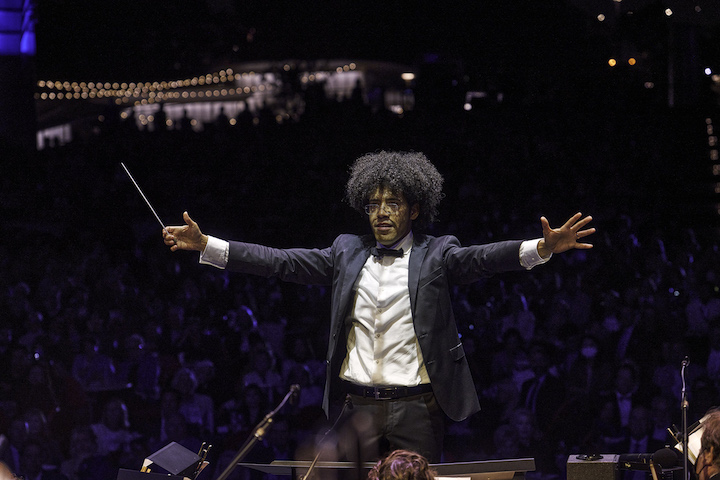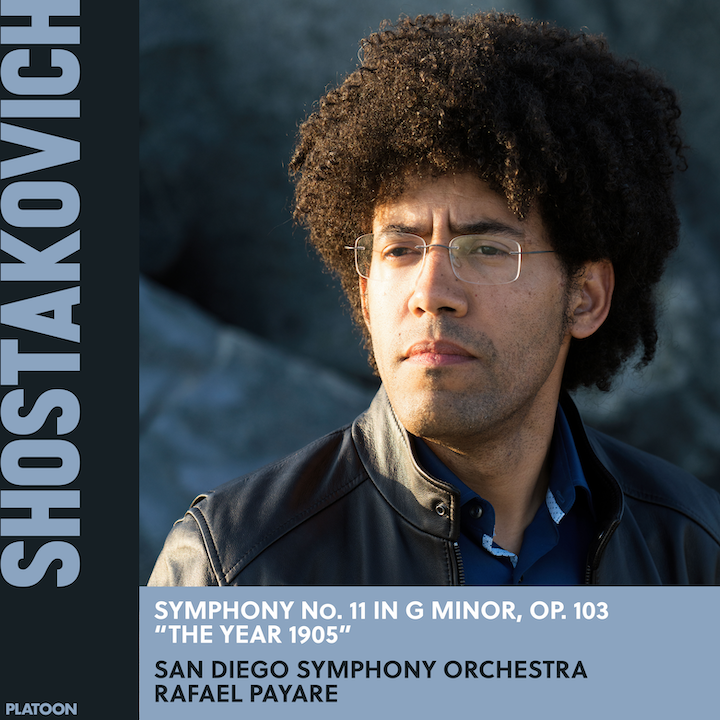This Fall Rafael Payare Showcases His “Visceral, In-Your-Gut” Way with Shostakovich Symphonies at NY Phil Debut, on European Tour with Montreal Symphony, & with San Diego Symphony

Rafael Payare (photo: J. Henry Fair)
(October 2022) — Always “electrifying in front of an orchestra” (Los Angeles Times), Rafael Payare is already making his mark on the music of Shostakovich. Recorded with the San Diego Symphony, where the Venezuelan conductor is currently in his fourth season as Music Director, his 2022 account of the composer’s Eleventh Symphony, “The Year 1905,” has been hailed as “a mandatory purchase,” in which “the ferocity unleashed by Payare and his San Diego players is really visceral, in-your-gut stuff” (Fanfare magazine). Now, having just inaugurated a second position as Music Director of the Montreal Symphony Orchestra (OSM), Payare continues his exploration of Shostakovich’s music. He and OSM perform the composer’s searing Tenth Symphony in Montreal, Zagreb, Budapest, Vienna and London (Oct 12–28), while the vivid yet often underrated Twelfth Symphony, “The Year 1917,” is the vehicle for the conductor’s upcoming concerts with the San Diego Symphony (Nov 12 & 13) and his debut with the New York Philharmonic (Dec 1–3), where the work has never previously been performed.
Styling Payare “a fireball of energy onstage,” the Wall Street Journal affirms: “He is a musician to watch.” The conductor was 14 years old when he began his musical education in Venezuela’s El Sistema training program, where he developed a burning sense of mission. He says:
“It’s very important that we expose as many people to music as possible. I was lucky enough to be in Venezuela at the right time to have the exposure that I had. I want more people to have that chance and to experience personally the wonderful, ridiculous power of music.”
It is this deep-seated sense of purpose that fuels Payare’s impassioned performances of the Shostakovich symphonies, of which he is fast becoming known as one of today’s most cogent and incisive interpreters. Living and working in Soviet Russia, Dmitri Shostakovich (1906–75) performed a delicate political dance. Writing music for propaganda purposes but infusing his scores with veiled criticism of the state, he ostensibly toed the party line even while subverting it. As a result, during his lifetime Shostakovich found himself alternately celebrated and denounced by the Soviet regime, and his politics continue to be a source of controversy and confusion in the West today: controversy and confusion that is only exacerbated by Russia’s current role on the political stage. About the composer’s Tenth, Eleventh and Twelfth Symphonies, which date from the years immediately after Stalin’s death, Payare explains:
“In all of Shostakovich’s music, and certainly in these three symphonies, there is a representation of reality that is portrayed in the most brutal way. And while the music makes a strong visceral impact, it is also very deep, conveying the harsh realities the composer faced but also his extraordinary resilience.”
This resilience is exemplified by the Tenth Symphony. Payare continues:
“Shostakovich wrote the Tenth Symphony soon after Stalin died. After the denunciation of the composer by Soviet authorities following his Ninth Symphony, he was blocked for a few years and confined to writing circus and film music. But when he started writing symphonies again, was he still the same person or was he a shell of a person? At the end of the Tenth Symphony, he wrote his personal motto – the famous D-S-C-H motif – into the music. He has survived, yes, but what has really changed?”
Shostakovich’s Twelfth Symphony dates from eight years later. Dedicated to Lenin and vividly cinematic in its depiction of the revolution, the work has been perceived as especially problematic; indeed, it has never previously been programmed by the New York Philharmonic. Yet it represents a powerful statement against tyranny and brutality. Payare says:
“Shostakovich was writing about historical events, but the music is also about his present realities and is deeply rooted in his personal experience. While this piece, subtitled ‘The Year 1917,’ hasn’t been programmed as often as the two that came before it, we find many of the same qualities in the music: raw expression of brutality and violence, but also extraordinary resilience – extremely personal, yet universal.”
Both symphonies figure prominently in the conductor’s upcoming engagements. This month he and the Montreal Symphony, the only Canadian nominee in the history of Gramophone’s Orchestra of the Year award, showcase their interpretation of Shostakovich’s Tenth in concerts at home (Oct 12 & 13) and then on their first European tour together, with performances in Zagreb (Oct 21) and Budapest (Oct 22), at the Vienna Konzerthaus (Oct 23), and at London’s Royal Festival Hall (Oct 28). Alongside compositions by Liszt (Oct 12, 21 & 22) and Samy Moussa (Oct 23 & 28), their program features Icelandic pianist Víkingur Ólafsson as the soloist in Ravel’s G-major Piano Concerto, except in Vienna, where Payare and OSM will instead be joined by Canada’s Bruce Liu, winner of the 2021 Chopin Competition, for Rachmaninoff’s Rhapsody on a Theme of Paganini. The conductor’s extraordinary affinity with the orchestra is already very much in evidence, and last month he launched his tenure with a season-opening concert that “will be remembered as a major milestone in the history of the OSM” (Le Devoir, Canada).
At concerts that mark not only his own New York Philharmonic debut but also the orchestra’s premiere performance of Shostakovich’s Twelfth Symphony, Payare juxtaposes the work with Beethoven’s Second Piano Concerto, featuring Grammy-winner Emanuel Ax, and Darker America, a symphonic poem in which William Grant Still explores sorrow, prayer and hope in Black American life (Dec 1–3).
Shostakovich’s Twelfth also takes Payare back to the San Diego Symphony (SDSO), where he combines it with the U.S. premiere of Thomas Larcher’s Time, an SDSO co-commission, and the same Beethoven piano concerto, again with Ax as soloist (Nov 12 & 13). As Music Director of the orchestra, the conductor has already proven himself transformative, prompting the Los Angeles Times to marvel: “San Diego is suddenly a symphonic destination.”

These fall engagements follow Platoon’s spring release of Payare’s live account of Shostakovich’s Eleventh Symphony, “The Year 1905” with the San Diego Symphony. Composed at the height of the Cold War, in the wake of the 1956 Hungarian uprising, the work depicts one of the most violent and tragic events in Russian history, while offering what is widely understood to be a coded critique of the Soviet regime. Payare explains:
“As its subtitle suggests, the Eleventh is about the Russian revolution of 1905, but it’s also a response to events in Hungary in 1956, and the Soviet crackdown on the uprising there.”
Representing the first commercial recording of the conductor’s career, the album has proved a resounding critical success. See what critics are saying below:
“One of the most musical readings of the Shostakovich Eleventh in the catalog. … It’s guaranteed to put both conductor and orchestra on the map in a big way. In my opinion, any orchestra that can play like this is automatically and instantly elevated to one of the top-tier ensembles in the country, and any conductor who can lead it as Payare does is automatically and instantly elevated to the status of a top-tier conductor. … A magnificent achievement.”– Fanfare magazine
“This streamed offering from San Diego is right up there with the best we have. … Powerful and articulate playing from all departments of the San Diego Symphony.” – Gramophone magazine
“The success of the conductor and his excellent orchestra … is definitely a contender for next year’s Grammy. … This first step by our new leader into the world of recording is relevant and encouraging.” – Le Devoir
“The performance grips attention throughout, achieving warmth and nobility at the big climax. … Impressive achievement.” – BBC Music magazine
“The San Diego Symphony has captured the immense, Mussorgskyian power and cinematic sweep of this epic work.” – Strings magazine
“A riveting showcase for the orchestra’s power and finesse. Payare and the musicians scale new heights with such assuredness that it suggests the start of a new era that should easily command broader attention.” – San Diego Union Tribune
High-resolution photos are available here.
rafaelpayare.com
www.facebook.com/RafaelPayareConductor
www.instagram.com/rafaelpayareconductor
twitter.com/rafaelpayare
Rafael Payare conducts Shostakovich symphonies live this fall
Oct 12 & 13
Montreal, Canada
Montreal Symphony Orchestra
SHOSTAKOVICH: Symphony No. 10
LISZT: Les préludes (Oct 12 only)
RAVEL: Ma mère l’Oye, Suite (Oct 13 only)
RAVEL: Piano Concerto in G (with Víkingur Ólafsson, piano)
Oct 21–28: European tour with Montreal Symphony Orchestra
Oct 21: Zagreb (Vatroslav Lisinski Hall)
SHOSTAKOVICH: Symphony No. 10
LISZT: Les préludes
RAVEL: Piano Concerto in G (with Víkingur Ólafsson, piano)
Oct 22: Budapest (Müpa)
SHOSTAKOVICH: Symphony No. 10
LISZT: Les préludes
RAVEL: Piano Concerto in G (with Víkingur Ólafsson, piano)
Oct 23: Vienna (Konzerthaus)
SHOSTAKOVICH: Symphony No. 10
Samy MOUSSA: Elysium
RACHMANINOFF: Rhapsody on a Theme of Paganini (with Bruce Liu, piano)
Oct 24: Vienna (Konzerthaus)
BRAHMS: Nänie & Schickalslied (with Wiener Singakademie)
MAHLER: Symphony No. 5
Oct 27: Brussels (BOZAR)
PROKOFIEV: Violin Concerto No. 5 (with Augustin Hadelich, violin)
MAHLER: Symphony No. 5
Oct 28: London (Royal Festival Hall)
SHOSTAKOVICH: Symphony No. 10
Samy MOUSSA: Elysium
RAVEL: Piano Concerto in G (with Vikingur Ólafsson, piano)
Nov 12 & 13
San Diego, CA
San Diego Symphony
SHOSTAKOVICH: Symphony No. 12, “The Year 1917”
Thomas LARCHER: Time (U.S. premiere of SDSO co-commission)
BEETHOVEN: Piano Concerto No. 2 (with Emanuel Ax, piano)
Dec 1–3
New York, NY
New York Philharmonic (debut)
SHOSTAKOVICH: Symphony No. 12, “The Year 1917”
STILL: Darker America
BEETHOVEN: Piano Concerto No. 2 (with Emanuel Ax, piano)
# # #
© 21C Media Group, October 2022